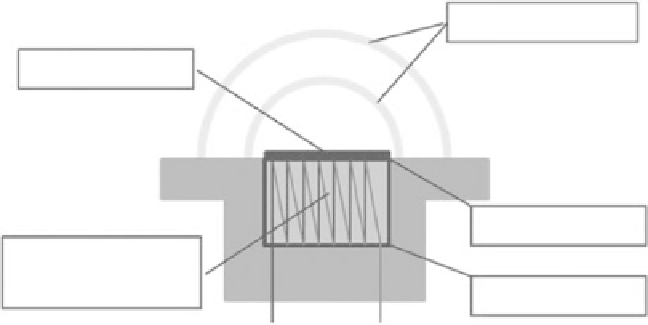Geoscience Reference
In-Depth Information
(a)
Glass domes protect and
filter solar radiation
Treated surface
absorbs solar energy
(b)
Hot surface warmed by
radiation
“Thermopile” measures
temperature difference
between surfaces
Cool surface in metal at
air temperature
+
−
Figure 7.2
(a) Operating principle of a thermoelectric sensor for measuring solar radiation; (b) Kipp and Zonen
pyranometer which uses the thermoelectric method. (From Kipp and Zonen, 2010.)
pyranometer, solar radiation is measured using the thermoelectric effect from the
difference in temperature between the surface heated by solar radiation and the
body of the instrument. A thermopile comprising many bi-metallic junctions
connected in series is used to generate the voltage produced. Glass domes are used
to provide protection for the surface receiving solar radiation and to inhibit
convection from the blackened surface. These domes also act as a filter, restricting
incoming energy to that arriving in the solar waveband. Many of the pyranometers
in common use today are thermoelectric sensors that use this approach.
Photoelectric pyranometers
Photoelectric pyranometers use silicon photovoltaic detectors that provide an
electrical output proportional to the radiant energy falling on the semiconductor.
The sensitivity of photovoltaic detectors is not uniform with wavelength and they
are not sensitive to the full spectrum of the energy incident in the solar beam, see
Fig. 7.3a. Photoelectric pyranometers therefore require careful calibration against
a standard sensor before use. It is assumed that any changes in the incoming solar
spectrum, in changing meteorological conditions, does not greatly influence the
calibration of the instrument. Commercial photoelectric pyranometers (see 7.3b)
are, however, less expensive and easier to use than other pyranometers and they are
popular because of this. After careful calibration, the error in the measurement
they provide can be less than 5% under most conditions of natural daylight.
By carefully introducing filters above the active surface, photovoltaic sensors
can be designed to measure the incoming energy in selected wavebands. The most
common requirement is for sensors which measure incoming energy in the 0.4
μ
m
to 0.7
m waveband, this being the range of wavelengths used by plants for photo-
synthesis. Such sensors are usually referred to as
quantum sensors
.
μ






